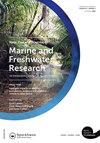泰提姆,泰帕里,潮汐的涨落:与怀马塔伊人一起从山到海工作
IF 1.7
4区 环境科学与生态学
Q3 FISHERIES
New Zealand Journal of Marine and Freshwater Research
Pub Date : 2022-07-03
DOI:10.1080/00288330.2022.2096084
引用次数: 4
摘要
本文来自马斯登的一个项目“让河流说话”,该项目聚焦于吉斯伯恩的怀马塔伊河,将mātauranga和wānanga的见解与广泛的学科结合起来,产生了对ki uta ki tai的创新和参与的理解-从山到海的河流的生命。在Te Ao Māori中,水道是whakapapa网络中相互关联的结/节点/链,产生于大地与天空、陆地与海洋之间的交换。这种方法承认大气、地表水和地下水、植被覆盖、土地利用、水质和水量、海洋、植物、动物、微生物和人之间的关系;河流有自己的权利,有自己的权利。《让河流说话》是由iwi研究人员、来自地球系统科学、地貌学、微生物学和传染病、森林生态学、人类学、创造性实践和商业研究的学者与河流共同开发的。它是整体性的,跨越不同的知识体系,了解水道与人类和其他生命形式的关系的全部复杂性。与此同时,它也充满希望,为使河流和河口社区恢复到ora(健康、幸福、繁荣)状态的行动提供了一个关系框架。本文章由计算机程序翻译,如有差异,请以英文原文为准。
Tai Timu, Tai Pari, the ebb and flow of the tides: working with the Waimatā from the Mountains to the Sea
ABSTRACT This paper emerges from a Marsden project, Let the River Speak, focused on the Waimatā River in Gisborne, bringing insights from mātauranga and wānanga together with a wide range of disciplines to produce innovative and engaged understandings of ki uta ki tai-the life of rivers from the mountains to the sea. In Te Ao Māori, waterways are relational knots/nodes/strands in a meshwork of whakapapa that arises from exchanges between earth and sky, land and sea. This approach acknowledges the relations between the atmosphere, surface water and groundwater, vegetation cover, land use, water quality and quantity, the sea, plants, animals, micro-organisms and people; and rivers as beings in their own right, with their own rights. Let the River Speak is codeveloped with the river by a team including iwi researchers, scholars from earth system science, geomorphology, microbiology and infectious diseases, forest ecology, anthropology, creative practice, and business studies. It is holistic, working across different knowledge systems to understand the full complexity of waterways in relationship with people and other life forms over time. At the same time, it is hopeful, providing a relational framework for actions to restore river and estuarine communities to a state of ora (health, well-being, flourishing).
求助全文
通过发布文献求助,成功后即可免费获取论文全文。
去求助
来源期刊
CiteScore
4.50
自引率
12.50%
发文量
35
审稿时长
3 months
期刊介绍:
Aims: The diversity of aquatic environments in the southern continents and oceans is of worldwide interest to researchers and resource managers in research institutions, museums, and other centres. The New Zealand Journal of Marine and Freshwater Research plays an important role in disseminating information on observational, experimental, theoretical and numerical research on the marine, estuarine and freshwater environments of the region.

 求助内容:
求助内容: 应助结果提醒方式:
应助结果提醒方式:


